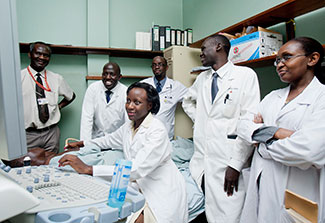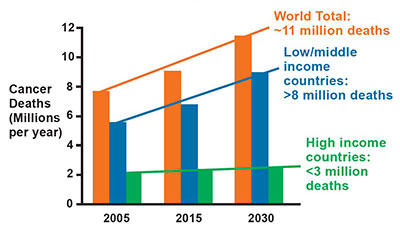Focus on cancer: NIH supports cancer research to reduce disease burden
July / August 2018 | Volume 17, Number 4

Photo by Richard Lord for Fogarty
Trainees in Uganda learn to scan patients for breast cancer
with support from Fogarty’s Medical Education Partnership
Initiative.
By Karin Zeitvogel
Cancer is increasingly striking populations in low-resource settings, due to rising longevity and other risk factors. Around 70 percent of the 8.8 million cancer deaths that occurred globally in 2015 were in low- and middle-income countries (LMICs), where most new cancer cases are diagnosed and there are the fewest resources to treat them. The forecast is grim, with the WHO predicting the number of new cases will increase by more than 50 percent by 2030.
Lung cancer is the most common cancer in the world. Of the estimated 1.8 million new cases worldwide in 2012, 58 percent were in less developed regions. Most cases are caused by smoking - and around 80 percent of the world's 1.1 billion smokers live in LMICs, according to the WHO.
Breast cancer is the second most common cancer, according to WHO’s 2012 data, although a more recent report shows that it may have surpassed lung cancer to become the most common globally. Improved screening and care have meant the mortality rate for breast cancer has fallen but those gains have been concentrated in high-income regions. In sub-Saharan Africa, where many women present with late-stage disease, fewer than half survive beyond five years, compared with nearly 90 percent in the U.S.
Caused by the human papilloma virus (HPV), cervical cancer is the most common cancer among women in parts of Africa, Asia and Latin America. It is three times more likely to occur in HIV-infected women, whose immune systems are too weak to fight an HPV infection, than uninfected women. Together with Kaposi’s sarcoma and non-Hodgkin’s lymphoma, cervical cancer is considered an HIV-associated malignancy, which are more prevalent in LMICs where HIV infection continues to be widespread.
Other common cancers in developing countries include prostate, liver, stomach and esophageal cancer.
Researchers note that cancer instances are likely underreported in resource-poor countries, as few have cancer registries. Only around 11 percent of the population in Africa and six percent in Asia are covered by registries. Cancer prevalence in LMICs is expected to continue to grow because of:
- Improved treatment and prevention of childhood, infectious and parasitic illnesses, and lower maternal mortality rates, which have allowed people to live into middle- and old-age, when most cancers occur.
- Rising rates of obesity caused by changes to diet and reduced levels of physical activity due to urbanization and other causes. Obesity has been associated with more than a dozen cancers including breast - particularly in post-menopausal women - ovarian, esophageal and colorectal.
- Gene mutations, environmental factors such as indoor and outdoor pollution, and viral illnesses in addition to HIV, including hepatitis B or C, are also risk factors for cancer.
Cancer deaths rising fastest in LMICs

Data Source:
Globocan
Cancer currently accounts for ~12.5% of global deaths
Description of graph: Bar graph shows cancer deaths in millions per
year, comparing the world total to deaths in LMICs and High-income
countries. By 2030 the estimated world total is approximately 11 million
deaths, with more than 8 million deaths in LMICs, and less than 3 million
deaths in high-income countries.
To stem the tide of cancer in LMICs, scientists say a multi-pronged approach is needed. Fogarty and NIH partners are supporting numerous projects to improve cost-effective and practical diagnostic tools and treatment options, explore genomics research, study tobacco cessation approaches and deploy mobile technology solutions, among others.
Studying cancers that are common in Africa, Asia or Latin America but rare in developed countries has allowed researchers to “reverse innovate” and use their findings to help cancer patients in the developed world - such as by bringing down the cost of treatment and finding less invasive ways to treat cancer.
Researchers are also working to establish and expand cancer registries, which indicate how common certain cancers are, how frequently they occur, how well people are surviving and if there are clusters caused by environmental degradation or infections like HIV - all of which change a person’s risk for cancer and can provide useful directions for future studies.
More Information
-
Cancer incidence and mortality worldwide: Sources, methods and major patterns in GLOBOCAN 2012
International Journal of Cancer, September 13, 2014 -
Cancer rates decline in many high-income countries, but rise in lower-income countries
American Association for Cancer Research news, December 14, 2016 -
Redefining global health priorities: Improving cancer care in developing settings.
Journal of Global Health, June 2014 -
Global health from a cancer care perspective
Future Oncology, August 3, 2015 -
Developing national cancer registration in developing countries – case study of the Nigerian national system of cancer registries
Frontiers in Public Health, July 30, 2015 -
Estimating the incidence of breast cancer in Africa: a systematic review and meta-analysis
Journal of Global Health, June 2015 -
Burden of cancers attributable to infectious agents in Nigeria: 2012–2014
Frontiers in Oncology, October 24, 2016 -
Challenges in the detection, prevention, and treatment of HIV-associated malignancies in low- and middle-oncome countries in Africa
Journal of Acquired Immune Deficiency Syndromes, June 2014 -
Infection-related cancers: prioritizing an important and eliminable contributor to the global cancer burden
The Lancet Global Health, September 2016 -
HIV-associated malignancies: strengthening capacity for research for HIV-associated malignancies in Africa and other low- and middle-income countries (LMICs)
NCI/NIH news, July 10, 2017 -
The Burden of Cancer
The Cancer Atlas, produced by the American Cancer Society, the International Agency for Research on Cancer, and the Union for International Cancer Control -
GLOBOCAN Fact Sheets on all cancers
Resources and publications related to the article
Research, technology fight cancer in LMIC women:
-
Population-level scale-up of cervical cancer prevention services in a low-resource setting: Development, implementation, and evaluation of the cervical cancer prevention program in Zambia
PLoS One, April 17, 2015 -
Stage at diagnosis of breast cancer in sub-Saharan Africa: a systematic review and meta-analysis
The Lancet Global Health, December 2016 -
Efforts towards erasing borders in gynecologic cancer?
Gynecologic Oncology Reports, August 2017 -
Cohort profile: African Collaborative Center for Microbiome and Genomics Research’s (ACCME's) human papillomavirus (HPV) and cervical cancer study
International Journal of Epidemiology, December 2017 -
Closing the breast cancer divide in sub-Saharan Africa
Fred Hutchinson Cancer Research Center news, August 15, 2017 -
Burden of cancers attributable to infectious agents in Nigeria: 2012–2014 [Open access]
Frontiers in Oncology, October 24, 2016 -
A prospective study of obesity, metabolic health and cancer mortality among blacks and whites
Obesity (Silver Spring), January 2018 -
Factsheet on breast cancer from Globocan
-
Factsheet on cervical cancer from Globocan
- Related grants:
Resources and publications related to the article
Vietnam project studies text messages to curb smoking:
Resources and publications related to the article
Global studies show single dose of HPV vaccine provides protection:
Resources and publications related to the article
Fogarty and NIH have catalyzed cancer research in Malawi:
- Related organizations:
- Related grants with Fogarty support:
- Related news and publications:
-
Breast cancer knowledge, behaviors, and preferences in Malawi: Implications for early detection interventions from a discrete choice experiment
Journal of Global Oncology, October 1, 2017 -
From the ground up: The state of cancer care in Malawi
UNC School of Medicine news, August 24, 2017 -
The path from a volunteer initiative to an established institution: evaluating 15 years of the development and contribution of the Lighthouse trust to the Malawian HIV response [Open access]
BMC Health Services Research, August 9, 2017 -
High rates of cervical cancer among HIV-infected women at a referral hospital in Malawi
International Journal of STD and AIDS, August 2016 -
Early experience after developing a pathology laboratory in Malawi, with emphasis on cancer diagnoses
PLoS One, August 7, 2013
To view Adobe PDF files,
download current, free accessible plug-ins from Adobe's website.